Fiddling With Phyllo
- andreasachs1
- Mar 6, 2023
- 5 min read
Updated: Mar 7, 2023
By Bonnie Fishman / San Francisco Bay Area
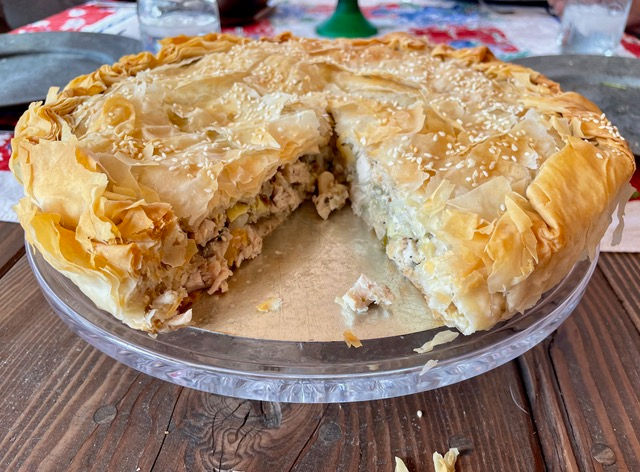
You may spell it “filo,” while I spell it “phyllo.” But it’s all pronounced the same way: FEE-low. Phyllo, which means leaf in Greek, is a very thin pastry made of flour and water. It is amazingly versatile and handy to have in your freezer at all times, just in case you need to throw together a quick appetizer, dinner, or dessert. Countries around the Middle East, such as Turkey and Greece and some Balkan countries have been using this pastry for millennia. The Greeks lay claim to it because it was recorded in Homer’s Odyssey in 800 B.C. The Turks maintain that it originated in the 11th century during the Middle Ages.

Many people shy away from using phyllo dough because it can be very difficult to work with. It dries out quickly and becomes brittle, causing culinary grief. The usual solution is to have a damp tea towel to cover the pack with, while you use a sheet or two at a time. I personally rarely use this technique because I work fast and just fold the pile of sheets over when not in use.
But be warned: there is phyllo and there is phyllo. It is sold in the frozen section of the grocery store. In truth, not all boxes are the same. Sometimes, you’ll open a box and find that it’s already broken into strips and pieces. Worse yet, the whole box is welded together by God knows what. No salvaging that. There is no way of knowing this in advance. I recommend buying two boxes, one as a backup in case the first one is a bust.
It's worth the hassle, I promise. Once you get over your fear/frustration with the dough, you’ll love it!
I have never attempted to make phyllo from scratch. It’s one of those persnickety doughs that you have to stretch and stretch by hand, hoping not to punch holes in it with your fingers. Quite frankly, most recipes have so much added to the phyllo that the flavor of it is hardly a factor. Take baklava, for example. It is the quintessential Middle Eastern dessert made with ground nuts, cinnamon, sometimes rose water, and doused with honey. The dough is really a vehicle to glue all that stuff together.

When I had my gourmet food shops from 1980-2009 in Bloomfield, Mich., phyllo triangles were our most popular appetizer. The beauty of these was the different fillings that we offered: spinach and cheese, mushroom and cheese, curried chicken, spicy beef with pine nuts. You get the picture.
The best feature of them all was our ability to make them in huge batches and freeze them on large sheet pans raw. The customer would bake them right out of their own freezer for a terrific result.
Because we had large stainless steel work benches, we would lay out piles of phyllo dough in rows, brush them with butter, cut them in strips, fill them, and roll them up in a flag fold. This was all done assembly-line style, which made for a speedier task. When I make them at home, I try to work with more than one sheet at a time to replicate the large batches.
As far as desserts are concerned, one can use the dough to make individual sweetened turnovers filled with cinnamon, sugar, apples, bananas or chocolate, or even a crushed nut frangipane filling. Go for it!
The versatility of phyllo dough can’t be emphasized enough. Because it is unsweetened and basically has very little flavor of its own, you have a blank canvas to work on. The most common savory use is spinach pie. It’s often baked in a large casserole and cut into squares. It can also be made as large individual triangles.
One time, when I was in Albania in 2018, I discovered that they have a delicious street food called Borek, eaten with the hands. (What was I doing in Albania, you ask? I was in Corfu and it was a mere 20-minute ferry ride across the Ionian Sea.) It is layers of phyllo with spinach, cheese, egg, and other vegetables. It was so delicious!
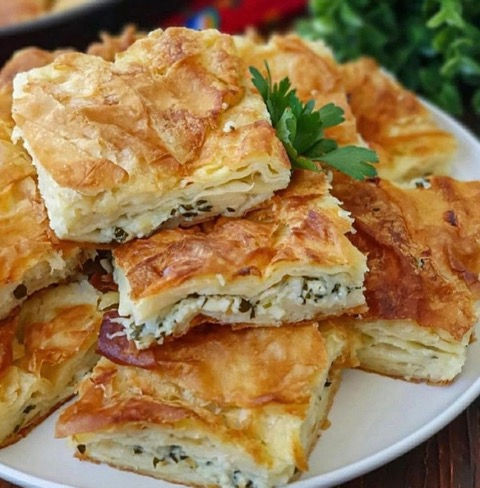
Today’s recipe is a twist on using a casserole. I’m lining a large-fluted tart pan with many layers of buttered phyllo, filling it with a Greek chicken mixture, and covering it with a top layer of dough. After baking, it is cut into wedges. It is a delightful lunch or brunch dish served with a crisp green salad. It also reheats nicely. There can be many riffs on this filling by adding different cooked vegetables. Don’t forget to use the rice as it is the binder for the ingredients.
Let us know at The Insider what phyllo recipe you tackled and whether you were successful or aggravated!
Greek Chicken Pie with Artichokes
Yield: 8 servings
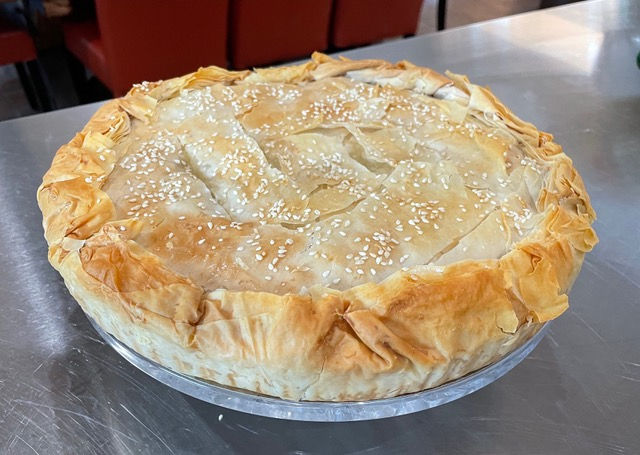
1 1/2 lbs. thin cut boneless, skinless chicken breasts
1/2 c. white wine
2 Tbsp. olive oil
4 c. finely chopped onions
2 garlic gloves, minced
1 can artichokes, drained, coarsely chopped
3 Tbsp. Arborio rice
2 Tbsp. pine nuts
2 Tbsp. fresh chopped oregano
1 lg. egg + 1 egg white, whisked together
1 tsp. salt
1 tsp. ground black pepper
1/2 tsp. ground cinnamon
1/4 tsp. fresh grated nutmeg
1 lb. box phyllo dough
4 oz. butter or margarine, melted
sesame seeds for garnish
Place the chicken in a large skillet. Season with salt and pepper. Pour on the wine and add enough water to barely cover. Poach chicken in simmering liquid for about 10 minutes, turning once. Remove from the pan and place on a cutting board. Cool to room temperature. Cut into 1/4” dice. Reserve.
Measure out 1/2 c. of the poaching liquid and reserve the rest for another use. Do not rinse pan. Over moderate heat, sauté the onions and garlic until translucent.
Put the chicken in a large bowl with the 1/2 cup liquid. Add the onions to the chicken. Allow to cool. Add the rice, pine nuts, oregano, whisked eggs, and seasonings.
Preheat oven to 350°. Spray an 11-12” fluted tart pan with a removable bottom with pan release. Reserve.
Have melted butter ready. Lay 1 sheet of phyllo horizontally on your work surface. Brush with butter. Lay a second sheet on a 45° angle on top of the first sheet. Brush with butter. Continue in the same fashion with 5 more sheets, always laying the phyllo on a 45° angle.
Carefully lift up the pile of phyllo and set in the middle of the tart pan. Fit into the corners of the pan. Fill with chicken mixture and smooth out the top.
Create another pile of phyllo using 7 sheets in the same fashion as before. Lift this on to the top of the tart. Using a kitchen shears, trim the dough, leaving a 2” edge. Discard excess phyllo. Tuck the edges into the tart pan, either underneath or on top. Cut 4 incisions in the tart for steam vents. Brush the top with melted butter. Sprinkle on the sesame seeds. Place the tart on a sheet pan as the butter sometimes leaks out of the bottom.
Bake for about 55 minutes or until golden brown. Let cool for 10 minutes before removing from the pan and serving.
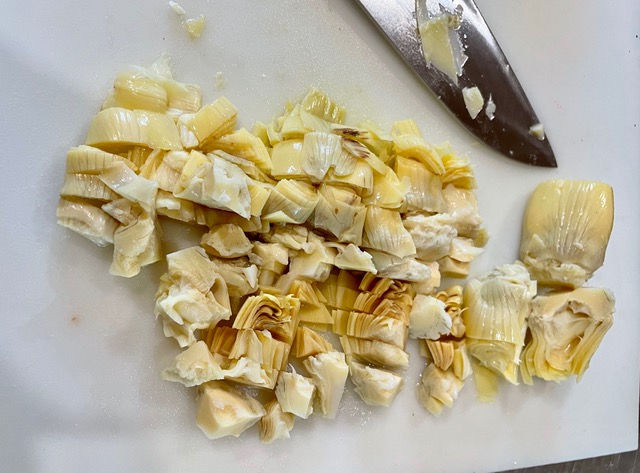
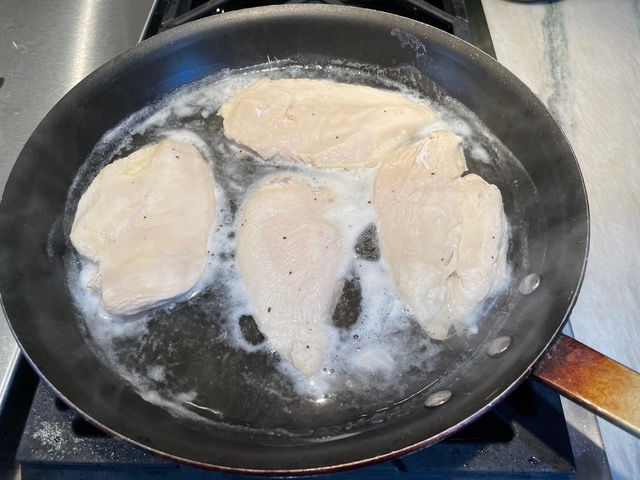


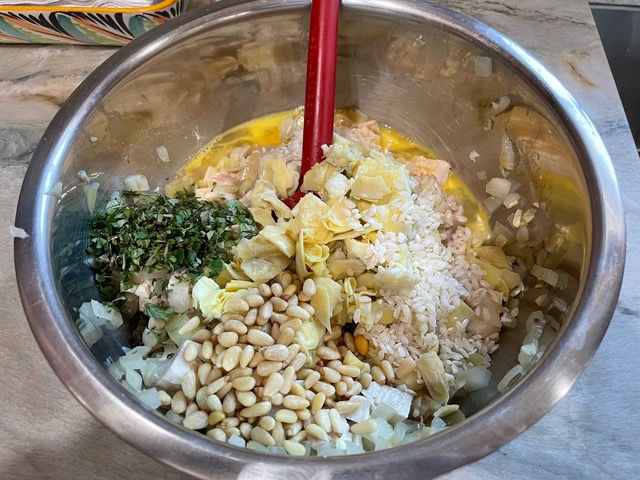


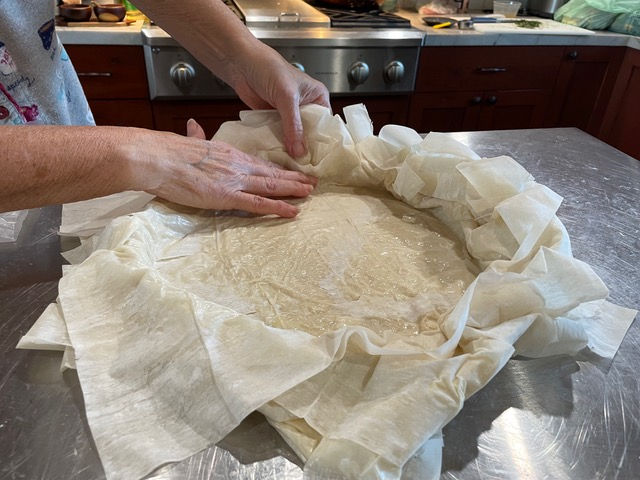
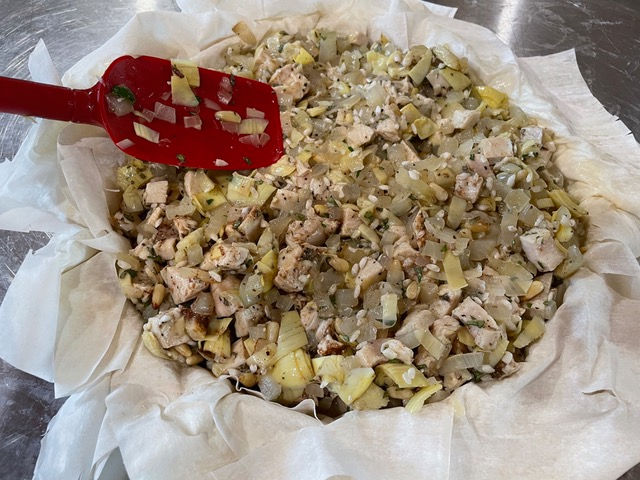
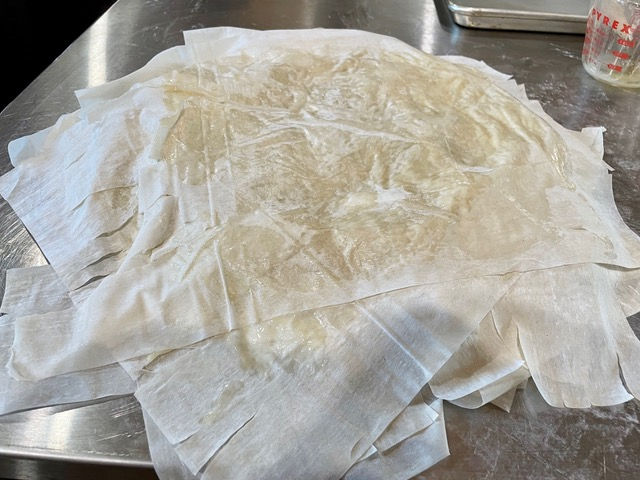





Bonnie Fishman attended the Cordon Bleu Cookery School in London. Later, she owned and operated Bonnie’s Patisserie in Southfield, Mich. and Bonnie’s Kitchen and Catering in Bloomfield Hills, Mich. She has taught cooking for over 35 years and created hundreds of recipes. She is now living in Northern California.
Since it's vegan and one in my household it, if I make something to share has to be vegan so in place of puff pastry dough I use phyllo instead to make what I call yuppie grilled cheese